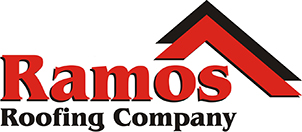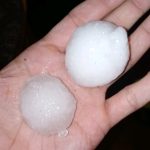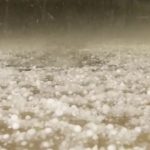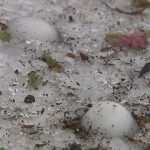Hail Damage Roof
Colorado Hail Storm Damage Roofing
Hail damage is fairly frequent and can wreak havoc on roof systems. But in the event of a hailstorm, try not to make any hasty conclusions about the need for roof repairs or replacement. Take time to carefully identify hail damage and whether it is considered functional damage before deciding whether to perform localized repairs of damaged roofing materials or replace the entire roof system.
Ramos Roofing offers free inspection and evaluation of your roofing system in Colorado after a hail storm. Only a full hail damage inspection will enable you to determine if your roof needs replacing or repair. We are also insurance claim specialists and can assist you in this process with your insurance company.
When there is a hail, wind or rain storm and a roof is damaged, this situation can be very burdensome for the homeowner. As a homeowner you have to consider many issues:
1. How am I going to get time to meet with roofing contractors?
2. Which roofing contractor to choose? Are they local or a storm chaser?
3. Is the roof contractor licensed and insured?
4. Will our home’s landscaping be damaged during the roofing project?
5. What costs will I endure?
Hail & Storm Damage Roof Repair & Replacement
Hail & Storm Damage Repair Contractors
There are many other considerations than can add to this list. Having a damaged roof can be very stressful for the homeowner.
At Ramos Roofing, we feel it is our duty to help put the homeowner at ease. We listen to our customers and understand their concerns, and we try to make this situation very painless for them. In many cases, homeowners should look at this damage not as a burden but instead as an opportunity.
If you have suffered hail, wind or rain damage to your roof, this can be an opportune time to transform a mediocre roofing system into a superior and beautiful roof enhancing your home’s value and appearance at a significantly reduced price. With a large contribution from your insurance company, you can upgrade your standard asphalt shingle roof into a luxury steep slope roofing system. Many of these environmentally friendly roof alternatives significantly increase the value of the home because of their look and performance. Not only are they beautiful, but because of the impact resistance and class A fire rating, in most cases they will reduce future insurance cost. Combining the reduced cost of hazard insurance, increased home value, and insurance company contribution, an upgrade to a luxury roofing material makes sense to many homeowners.
Steep Slope Roofing Systems
Composition Shingles
In many cases, hail related damage is only cosmetic and does not affect the useful life or effectiveness of roof shingles. Other times the hail can cause significant granule loss, severe wood splitting, penetration and fracture of the shingles requiring shingle replacement.
Hail damage to asphalt shingles is determined by granule loss, material loss at the edges of the shingles, and penetration or ruptures. New asphalt shingles can survive a hail storm better than old shingles since shingles become bitter over time. Warm shingles are more effective in hail storms versus colder shingles. Flexible roof shingles can flex during hail impact causing more damage, whereas a rigid roof sheathing supports the shingle during hail impact and it suffers less damage.
Concrete Tile
Concrete tile roofs are resilient. They can experience some fairly strong hail storms and not suffer significant hail damage. Some of the tiles may need to be replaced with a moderate hail storm. The underlayment of the concrete tile roof is just as important as the tile because this allows you to protect the interior of the building.
Clay Tile
Contrary to some opinions, Clay tile is not hail proof. Clay tile roofs can be destroyed by moderate hail storms. If you don’t live in a region that experiences hail storms frequently then clay tile is a very beautiful and long lasting roofing material.
Metal Roofing
Metal roofing is very resistant roof system. After a hail storm, your metal roof may look like a vehicle that went through a hail storm. However, in may instances, the metal roofs’ waterproofing abilities are not affected by the hail storm. Check with the manufacturer of your metal roof to find out if the metal roof has a Hail Resistance Rating.
Synthetic
Many synthetic roofs have good hail resistance ratings. Check with the roof material manufacturer whether your particular synthetic roof has a hail resistance rating.
Cedar or Wood Shake
Cedar or wood shake roofs are not hail resistant and you will not find a cedar roof product with any type of hail resistance rating. Make sure to have a full inspection of your cedar or wood shake roof system after a hail storm.
Low Slope Roofing Systems
Hail must be a certain size and hardness to functionally damage low-slope roof systems. However, the size required varies depending on low-slope roof system type and condition. Low Slope Roofing Systems are typically found on commercial buildings.
Built-up
A built-up roof (BUR) system is composed of a series of reinforcement bonded together with a waterproofing material such as asphalt, coal tar or polymer-modified bitumen. Hail of sufficient size, speed and hardness can puncture, tear or bruise a BUR membrane.
Polymer-modified bitumen
Polymer-modified bitumen membranes are composed of fiberglass and/or polyester reinforcement, and their top surfaces are protected by surfacing such as factory-embedded granules, factory-bonded foils or field-applied coatings.
Hailstones of sufficient size and hardness can puncture, tear or bruise a polymer-modified bitumen membrane where they strike and reduce the membrane’s weatherproofing capability. A roof systems’ expect service life can be reduced when hail disrupts the membrane’s protective surfacing and exposes its coating bitumen.
Single-ply membranes
Common thermoplastic membranes such as PVC and TPO typically incorporate reinforcement n woven forms known as scrims. The most prevalent thermoset roof membrane is EPDM, which is produced as reinforced (with polyester scrims) and non-reinforced membranes. Hail damage to thermoplastic membranes includes fractures or tears in the material body or reinforcement.
SPF
Spray polyurethane foam (SPF) roof systems are composed of multiple lifts of polyurethane foam finished with an elastomeric coating. Depending on hail’s attributes, resulting damage can range from fracture in the elastomeric coating to punctures in coating accompanied by crushing or fracturing of the polyurethane foam.
Metal
Inspectors will encounter many types of metal roofing materials. Metal can weather naturally or be protected by coatings. Panels are manufactured in a variety of widths and thicknesses with various types of seam configurations and applied with exposed or concealed fasteners.
When investigating hail damage, closely examine metal roofing panels. These can be damaged when hailstone parameters are sufficient to rupture the metal, disengage lap elements or disrupt protective coatings. Ruptures in panels and disengaged lap elements are obvious.
Contact Ramos Roofing
To schedule a roof estimate and inspection, or for more information contact us at your earliest convenience. We provide complete commercial and residential roofing services in Adams, Arapahoe, Boulder, Broomfield, Denver, Douglas, El Paso, Jefferson, Larimer, and Weld Counties in Colorado. See our Roofing Service Areas.








